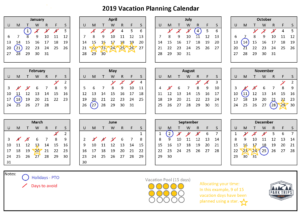The first step to planning a vacation is to intentionally set aside time to vacate from your normal routine using your planned time off. It pains me when I hear about folks forfeiting any portion of their employee vacation benefits. Over half of American’s leave some portion of their vacation time unused. With many firms employing a “use it or lose it” vacation policy, these folks never get the benefit of the paid time off (PTO) days that they give up.
Fear not friends! There is still hope! The best way that you can ensure that you don’t lose your hard-earned paid time off is to plan to use it all! Below, I outline the PTO planning approach that I use to create my time off plan. Happy Planning!
1. Grab a paper copy of your 1-page time off calendar.
It is nice to start with a blank calendar where you can view an entire year at once. Since you will be planning your time for the entire year, you will be able to easily map out where the holidays and other commitments fall and schedule accordingly.
Here is a link to a printable 1-page calendar.
2. Circle the holidays that your employer observes as paid time off.
For me, this includes all of the major federal holidays as well as a couple of optional holidays. To save you some time, I have listed the holidays that your employer may already provide you as paid time off. When you plan your vacation, you will want to validate this list to ensure that it is accurate for your situation.
2022 US Holidays:
- Saturday, January 1: New Years Day
- Monday, January 17: Martin Luther King Jr. Day
- Friday, February 18: President’s Day
- Monday, May 30: Memorial Day
- Sunday, June 19: Juneteenth
- Monday, July 4: Independence Day
- Monday, September 5: Labor Day
- Friday, November 11: Veteran’s Day
- Thursday, November 24: Thanksgiving Day
- Sunday, December 25: Christmas Day
3. List the times that you know will be busy times or times that will be difficult to be out of the office or away from home. (Tentatively) cross these days out on your calendar.
Do you have vacation black out days? Is your job cyclical where you know that certain periods of the month will be more difficult to get away because of the responsibilities that you have?
I tend to cross these times off of my vacation calendar so that I can avoid being out of the office, if possible. I find that it’s easier to get my management to grant the time off if I avoid busy times. It is also easier to get others to cover for you when there’s not as much going on. This means that you won’t have to transition as many tasks in order to completely disconnect while taking your vacation time.
Also, I want to note that I only tentatively cross these days off. Sometimes, there will be a conflict where you may need to be away (i.e. for a family wedding or graduation) that occurs during a busy time. Being able to see these in advance will enable you to plan ahead.
4. Determine your vacation pool or how much personal time off you have to use for the year.
I like to visualize 100% of my paid time off as circles where I draw one circle per day in my notes section. I treat floating holidays and other types of leave such as personal time as vacation days. I do exclude any paid sick time that I am allowed (because I don’t want to “plan” that time off – catch my drift?). You may choose to treat these types of time off differently than I do, but the point of this step is to determine your pool of vacation time available to use for the year.
If you don’t know how much time you have available to use, I recommend checking with your Human Resources representative or your offer letter (which typically will outline your paid time off benefits).
If your company has a “use it or lose it vacation policy” you want to make sure that you don’t leave your time off benefits by leaving them unscheduled. In the example below, I illustrate how I would draw out 3 weeks (15 days) of paid time off for the year.



5. Allocate your PTO days for the year
Now for the fun part! There are a number of considerations that I take into account when allocating my PTO days. Say you get a total of 3 weeks or 15 days of paid time off. Do you want to take off at least 2 days per quarter? When do you like to travel? What commitments do you have for the year (weddings, out of town graduations, etc.)? Who will you be travelling with, and what time-based constraints do they have? Read through the considerations below as you allocate your vacation pool for the year.
Consideration 1: When will you NEED time off? Priorities… priorities… priorities…
What demands have already been made on your time? Do you have any out of town commitments that you have already made that will require you to use some of your vacation time? Do you have any religious or personal holidays or anniversaries that you want to plan to take off for?
If so, mark these on your calendar. I tend to circle dates that are absolutely committed already. As I allocate a date, I will cross it off in my vacation pool so that my vacation pool only reflects the days that are available for me to allocate.
Consideration 2: When do you like to take time off?
I have noticed that a lot of people take off a chunk of vacation time at the end of the year. Some folks like saving all of their vacation for the end of the year. Some just happen to take time off at the end of the year because they run the risk of losing the benefit if they don’t take it.
I tend to not fall into that group. I find that the end of the year is a great time to work because it’s generally quiet and low key. I am able to get a lot done with low amounts of stress. I tend to like to take time off when I can enjoy the outdoors. Being a mid-westerner, I absolutely love to take time off during the warm late spring / early summer days and the cool but pleasant late summer / early fall times.
That being said, I like to take time off when the weather is nice and I can enjoy being outdoors. I encourage you to consider taking your vacation time when you will get the most joy from being in control of your schedule!
Consideration 3: Who will you be vacationing with? Do they have any constraints?
This is a “fun one” to try to coordinate (said with some sarcasm). It is important, however, to consider the time constraints of others that you might be travelling with.
For me, I plan to take most of my trips with Jason. While I have already considered the demands on my schedule, I will need to coordinate with him in order to pick a time that is mutually agreeable. I suggest that you do this before committing to any specific dates. Pick up the phone (or send a text) and see what dates might work with your travel companion.
Consideration 4: Length hacking tips to make the most of your employee vacation benefits
There are a couple of ways that you can take time to maximize the number of days that you will be out of the office. I tend to like these tips because it’s easy to plan longer trips while using fewer PTO days.
Tip #1: Take an entire week of PTO days in order to take advantage of both the leading and the trailing weekends.
For example, taking 5 days of vacation (Monday through Friday) enables you to tack on the Saturday and Sunday prior to the time off as well as the Saturday and Sunday after the time off providing you with a total of 9 days out of the office for only using five vacation days.
Tip #2: Make use of holidays or other planned time off in order to extend the length of your trip while having lower impact on the number of days that you will have to use.
For example, let’s say that you want to take a week-long trip, and you planned to take advantage of the weekends as discussed above. Now let’s say that you are able to plan that week-long trip during the week of Memorial Day. In this scenario, you will have a total of 9 days out of the office for only using four vacation days. Score!
Tip #3: Travel as a part of your job? If so, you might be able to vacation in a cool place just by extending your work trip a little.
Check with your employer to see what policies might exist, but you might have the opportunity to stay an extra day or more after a training or work event and avoid having to eat up time travelling back to your home in between. This could also end up saving you (and the company) some money. For example, let’s say that you attended a conference in Orlando, a place that you have always wanted to visit. Your conference ends Thursday, but you want to hang out for another couple of days because you didn’t really get a chance to explore. You might be able to work out with your employer an opportunity to fly back on say Sunday when rates are cheaper for your employer, and take Friday and Saturday at your leisure in your dream vacation destination for only the cost of your room, food and entertainment. All for the super-low vacation day cost of one-day!
Consideration 5: If you know where you want to go, when do you want to go there?
Are you going to be able to reach a travel goal and visit one of the places on your bucket list? If so, when is the best time to go there? For example, this year, Jason and I want to visit Acadia National Park in Maine. We are thinking that late summer / early fall will give us the opportunity to see some beautiful fall colors and avoid some of the frigid temperatures that are characteristic of off-peak travel in that area.
Pro Tip: Consider planning your vacation to avoid peak time travel in your destination.
In general, we enjoy avoiding peak travel times because it’s 1) cheaper and 2) less crowded. This is not by accident however, and you too can plan your trips simply by considering when you want to go instead of just falling into a time by chance.



6. Develop tentative plans based on your considerations above.
At this point, you’ve taken quite a few things into consideration. Now you’re ready to set some dates. As you settle upon dates, circle (or star) them on the calendar, and cross out the available days from your pool of vacation days that was established in step 4.
Another quick tip that I like to do is to set aside days where you know that you want to do something, but might not know the exact dates.
I tend to cross these dates off, knowing that I have allocated them but just haven’t assigned a date to them yet. For example, I know that I want to take off two days this year to do a mini-retreat in which I will do some planning / visioning for this blog. I don’t have exact dates set to do this, but I know that it will take two days away from my vacation pool.
7. Request the time off from work, and start planning to have a great time!!!
Enough said! This is the real fun part. You’ve considered times that minimize your impact from being away from work, and can now plan your vacation / trip. Before you leave for your trip, consider transitioning any assignments or deadlines to a coworker so that you are able to disconnect and take your vacation, worry-free.
That’s pretty much it. That is how I plan my vacation time for the year.
We have some more great planning content coming your way over the coming weeks to make your vacation dreams become a reality. We’ll send you updates to your email list when you subscribe.
What additional tips or considerations do you have when planning your paid time off for the year?

